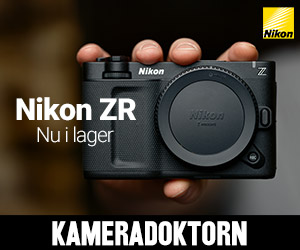Eeros
Aktiv medlem
Gimbal skrev:
Nej, ställer du två lika höga hinkar i regnet, varav den ena hinken är smalare så fylls de lika snabbt. Regnar det 5mm så blir det 5mm i båda hinkarna.
Men ställ dem under en vattenkran så får du se skillnaden...
Follow along with the video below to see how to install our site as a web app on your home screen.
Notera: This feature may not be available in some browsers.
Gimbal skrev:
Nej, ställer du två lika höga hinkar i regnet, varav den ena hinken är smalare så fylls de lika snabbt. Regnar det 5mm så blir det 5mm i båda hinkarna.
Gimbal skrev:
Det var ju skrämmande dåligt resultat för G9'an, var det alltså 9 gånger så många pixlar på den bilden innan nedskalning till samma storlek?
Mätningar i verkligheten tyder på att det inte är någon stor effekt. Finns den så överskuggas den flera gånger om av den tekniska utvecklingen. Nyare modeller har större dynamik trots mindre pixlar.photodo skrev:
Fillfactorn minskar således med pixelstorleken.
Jag förstår inte vad du menar, såvida det inte återigen är sämre fillfactor du menar, vilket jag redan har kommenterat. Om det inte är det du menar så låter det fel.men å andra sidan så kan vi börja räkna elektroner i skuggpartierna tidigare än när vi använder små pixlar.
Det råder ett gravt missförstånd här någonstans. En sensor som detekterar varje foton och dessutom exakt var på sensorn den träffar (infinitesimalt små pixlar och inget läsbrus) är teoretiskt perfekt. Den har inga "minskade möjligheter till höga ISO". Den kan inte bli bättre. Den slår alla existerande och alla framtidens kameror vid vilket ISO du vill. Orsaken borde vara lätt att inse: Den kastar inte bort någon information överhuvudtaget. Den levererar inte bilder "helt utan nyanser". Den skulle leverera teoretiskt perfekta bilder.Så länge vi väljer ett ISO som de små pixlarna kan omfatta (lågt ISO) så kan man säkert få fram riktigt bra hyggliga bilder
Du kan inte bara anta att bottenbruset (läsbruset) är konstant och oberoende av pixelstorleken. Det tenderar normalt att minska när pixelstorleken minskar. Jag har tidigare visat att FZ50 per ytenhet har mindre än hälften av läsbruset jämfört med 1D3, trots mycket mindre pixlar.photodo skrev:
DR begränsas i ena ändan av full well capacity och i den andra av brus. Man har på senare år minskat bottenbruset så att DR ökat för samma sensoryta. Men det finns en gräns då man inte längre kan minska bruset. Med mindre (inte färre) pixlar minskar också fwc och därmed DR.
Va? Det där var verkligen helt obegripligt. Det går alldeles utmärkt att skapa nyanser med den teoretiska sensor vid pratar om. Hur tror du att bläckstråleskrivare, även de med konstant droppstorlek, skapar nyanser? Denna teoretiska sensor spänner över alla ISO och exponeringar du vill. Med infinitesimalt små pixlar så kommer en överväldigande (en alldeles extremt stor majoritet till och med) att detektera 0 fotoner. Ju mer du exponerar desto fler pixlar detekterar en foton, men 99.999 (etc) procent detekterar fortfarande 0 fotoner.För att skapa nyanser krävs en yta bestående av många kristaller. Är det det vill se i en digitalkamera? Jag tror inte det. Vi vill ha en kamera som omspänner många ISO-tal (=många olika exponeringar).
Det gör jag inte heller. Hur stor skillnad tror du att det är i FWC för de två sensorer du talar om?joand skrev:
Du kan inte bara anta att bottenbruset (läsbruset) är konstant och oberoende av pixelstorleken.
Jag har en ganska klar bild över hur de gör. Hur tror du att en inkjetskrivare skapar nyanser?Hur tror du att bläckstråleskrivare, även de med konstant droppstorlek, skapar nyanser?
Det är lätt att slänga fram tvärsäkra påståenden John. Om man verkar tillräckligt säker på sin sak så kan en del läsare dessutom tro på dem. Vad är det för "teknisk utveckling" som flerfaldigt överskuggar den minskade fillfaktor som inte har "någon stor effekt"?joand skrev:
Mätningar i verkligheten tyder på att det inte är någon stor effekt. Finns den så överskuggas den flera gånger om av den tekniska utvecklingen. Nyare modeller har större dynamik trots mindre pixlar.
En 1D3-pixel rymmer ca 70000 elektroner, är 7.2 µ stor och har ett läsbrus på 23 elektroner. En FZ50-pixel rymmer ca 4800 elektroner, är 2 µ stor och har ett läsbrus på 2.3 elektroner. Skalar vi upp FZ50-pixeln så att vi jämför samma yta som en 1D3-pizel så motsvarar det en full well på 62200 elektroner och ett läsbrus på 8.3 elektroner.photodo skrev:
Det gör jag inte heller. Hur stor skillnad tror du att det är i FWC för de två sensorer du talar om?
Eftersom din bild är så klar så kan du förklara varför du tror att vår teoretiska sensor skulle ha svårt att producera nyanser.
Jag har en ganska klar bild över hur de gör. Hur tror du att en inkjetskrivare skapar nyanser?
Förnekar du att nyare kameror tenderar att ha bättre brusegenskaper trots att de har fler pixlar?photodo skrev:
Det är lätt att slänga fram tvärsäkra påståenden John. Om man verkar tillräckligt säker på sin sak så kan en del läsare dessutom tro på dem. Vad är det för "teknisk utveckling" som flerfaldigt överskuggar den minskade fillfaktor som inte har "någon stor effekt"?
Var har jag skrivit att jag tror att din teoretiska sensor har svårt att producera nyanser? Jag skrev: "För att skapa nyanser [i en film] krävs en yta bestående av många kristaller." En bildpixel med 256 nyanser (motsvarande cirka 8 stegs motivkontrast) kräver 256 st 1-bits sensorpixlar. För varje ISO-steg krävs en fördubbling av antalet sensorpixlar. Teoretiskt kan det funka. Men jag betvivlar starkt att vi får se en sådan "joand-sensor" i en kamera. Det är så en inkjetskrivare med endast en droppstorlek fungerar. Det är även så FM-raster för tryck fungerar. Till skillnad från AM-raster (traditionell raster) där man ändrar storleken på rasterpunkten. I princip samma nyansmetod som en sensorpixel med stort DR.joand skrev:
Eftersom din bild är så klar så kan du förklara varför du tror att vår teoretiska sensor skulle ha svårt att producera nyanser.
Nej. Kan du svara på min fråga med något annat än en motfråga? Vad är det för "teknisk utveckling" som flerfaldigt överskuggar den minskade fillfaktor som inte har "någon stor effekt"?joand skrev:
Förnekar du att nyare kameror tenderar att ha bättre brusegenskaper trots att de har fler pixlar?
Du skrev så här: "Fyll en sensorplatta med sådana pixlar. Man skulle kunna ta grafiska bilder vid exakt rätt exponering. Helt utan nyanser." Men strunt samma. Jag tycker att det var rätt uppenbart att det var ett tanke-experiment.photodo skrev:
Var har jag skrivit att jag tror att din teoretiska sensor har svårt att producera nyanser?
Det kan du säkert spekulera om lika bra som jag, Lars. Jag tror du försöker läsa in mer i vad jag skriver än vad som står där. Jag säger bara att när vi jämför olika kameror så ser vi en starkare korrelation mellan ålder och brusegenskaper än mellan pixelstorlek och brusegenskaper. Det faktum att man kan tillverka en sensor med 2 µ stora pixlar med lika bra prestanda per ytenhet som dagens bästa DSLR är bara ett exempel på den saken, dvs minskad fillfactor vid minskad pixelstorlek ser inte ut att vara ett så stort problem som du tror.photodo skrev:
Nej. Kan du svara på min fråga med något annat än en motfråga? Vad är det för "teknisk utveckling" som flerfaldigt överskuggar den minskade fillfaktor som inte har "någon stor effekt"?
När blev detta ett faktum? Var snäll och förklara för oss som inte accepterar detta som ett faktum. I vilken kamera hittar du 2 µm pixlar som är lika bra per ytenhet som i exempelvis Nikon D3? Jag vill se bildexempel! Eller menar du en hypotetisk kamera där man fyller en 24x36 mm sensor med 2 µm-pixlar? Är detta ytterligare ett förvirrande retoriskt "tankeexperiment"? Och vad är i så fall meningen med det; annat än att John skall få sista ordet i en debatt om att storleken på pixeln saknar betydelse?joand skrev: Det faktum att man kan tillverka en sensor med 2 µ stora pixlar med lika bra prestanda per ytenhet som dagens bästa DSLR är bara ett exempel på den saken, dvs minskad fillfactor vid minskad pixelstorlek ser inte ut att vara ett så stort problem som du tror.
photodo skrev:
När blev detta ett faktum? Var snäll och förklara för oss som inte accepterar detta som ett faktum. I vilken kamera hittar du 2 µm pixlar som är lika bra per ytenhet som i exempelvis Nikon D3? Jag vill se bildexempel! Eller menar du en hypotetisk kamera där man fyller en 24x36 mm sensor med 2 µm-pixlar? Är detta ytterligare ett förvirrande retoriskt "tankeexperiment"? Och vad är i så fall meningen med det; annat än att John skall få sista ordet i en debatt om att storleken på pixeln saknar betydelse?
Kan du inte bara tala om vilken kamera du menar? Du behöver inte leta upp några länkar åt mig.joand skrev:
Nu blir jag väldigt trött. Är "per ytenhet" svårt att förstå? Det finns länkar och bildexempel som jämför denna 2 µm pixelskamera med andra. Jag tänker inte leta upp dom åt dig.





